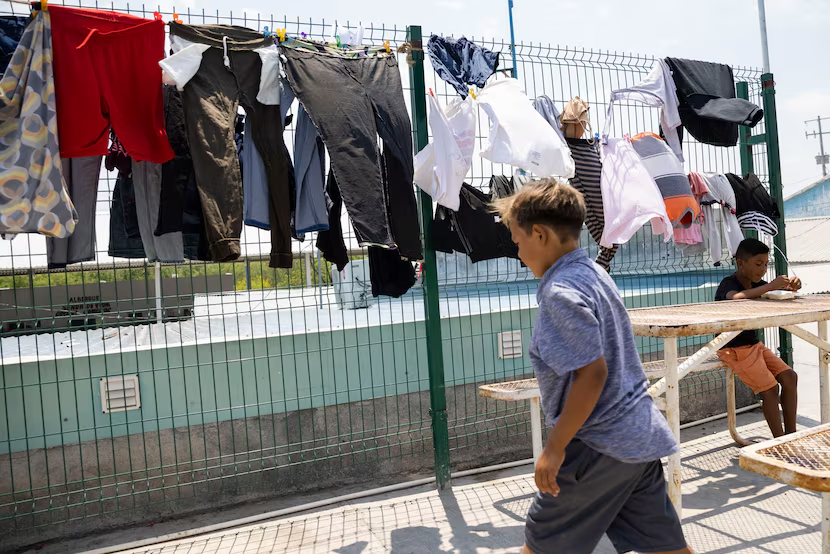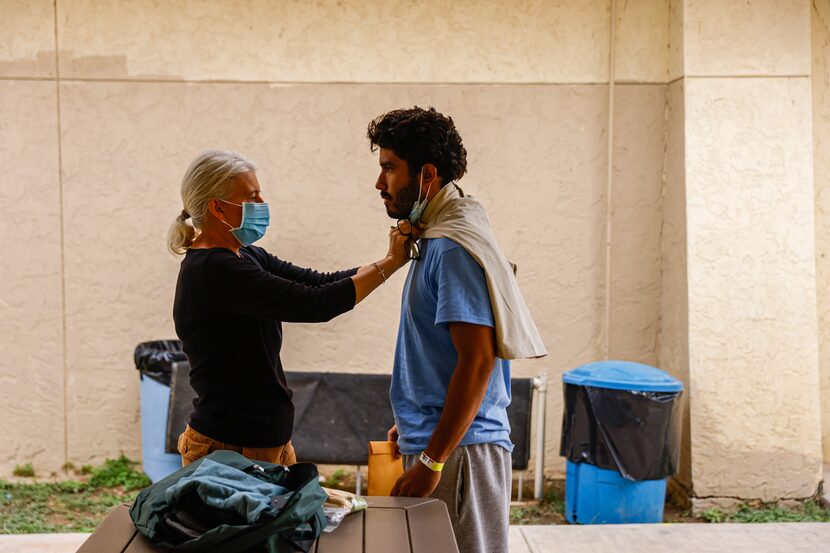Updated to reflect federal judge’s Title 42 decision.
The call for help came late in the evening to Felicia Rangel-Samponaro. Mexican authorities were clearing out a crowded tent camp of migrants and asylum-seekers from a city park in Reynosa, a Mexican border city near McAllen.
Rangel-Samponaro, a U.S.-based aid worker, and others scrambled across the Texas border into Reynosa to find shelter for hundreds of migrants who were displaced. Many went to safer, walled-in shelters that were already full, but made room for newcomers.
Her work illustrates one of the more troubling aspects of rising international migration: Many asylum-seekers have few places to stay in Mexico as they wait to try entry into the U.S. and they are often dependent on the generosity of private donors. In Texas border cities, a handful of nonprofits run shelters for overnight stays or for respites during daylight hours — and they, too, face funding hurdles.
Rising numbers of migrants — typical during the spring and summer — have arrived at the border. Many seek asylum. But those petitions have been delayed under a pandemic-related public health order, known as Title 42, that has been used nearly 2 million times since March 2020 to quickly expel migrants from the U.S. Critics, including the leader of the United Nations refugee agency, say it denies asylum-seekers their legal right to ask for refuge under U.S. and international law.

The public health order was set to expire Monday, but a federal judge in Louisiana on Friday kept Title 42 in place, siding with a collection of GOP-led states. The Justice Department has said it will appeal.
But for many immigrants, the legal wrangling has little impact on their decisions. Migration remains high, causing chaos and anxiety on both sides of the border.
“If you tell people to leave and you have a machine gun, you leave,” said Rangel-Samponaro, who co-founded the Sidewalk School to help the children of asylum-seekers.
That morning in early May, Rangel-Samponaro had gotten little sleep. She worked until almost dawn to settle people into four private shelters in Reynosa, a sprawling city of nearly a million people and the busiest border corridor for migration.
“They are incredibly stretched,” said Adam Isacson, a security specialist with the Washington Office on Latin America who has visited many camps and shelters on both sides of the border from Tijuana, Mexico, in the west to Matamoros, Mexico, in the east.
“These are some of the most selfless people I’ve met in all my work in Latin America. They have absorbed incredible amounts of trauma from the people that they talk to and work with. They are often working in the space of incredible threats. They’re really heroic.”
A test of fortitude now looms.
Camps cleared
For months, Mexican officials have said they wanted to clear the asylum-seekers from the Plaza de la República, a city park that became an outdoor refugee camp. In early April, about 2,500 to 3,000 persons wedged themselves into weathered tents in the park, a block from an international bridge. But numbers had fallen to fewer than 500 by early May.
Many went from the park to the faith-based shelter Senda de Vida. The Reynosa mayor quickly posted photos of the emptied park, with its graceful gazebo and dirt grounds where green grass once grew. A bulldozer lifted items left behind — tents and tarps, books and soccer balls. The remnants reflected the lives of dispossessed and displaced people.
“They’ve been talking about clearing it out forever,” said Sam Bishop, the country director for Global Response Management, a medical nonprofit staffed by many war veterans such as Bishop and health care volunteers. Global Response Management runs mobile clinics at several locations where Reynosa asylum-seekers cluster, including Senda de Vida, which reportedly now houses about 2,000 migrants. A second shelter had the capacity to hold about the same, nonprofit workers said.
“We are in it for the long haul,” said Bishop, the former Army medic in Iraq and Afghanistan who now works with Global Response Management.
Chaos is the new operational mode along the border. Attorneys to shelter operators to aid workers are in a constant scramble as ground conditions change and policies are applied to one nationality, such as Ukrainians, but not another.
“There is so much uncertainty and it makes it difficult for the advocacy community and the shelter community,” said Nico Palazzo, an attorney and border fellow with the legal nonprofit HIAS and working with Las Americas Immigrant Advocacy Center.
The network of shelters and nonprofits working the 1,900-mile stretch of border raises questions of how long their resources would last. Could they keep going if migration continued at the high levels of March and April, when more than 200,000 each month were caught by the U.S. Border Patrol?
Future uncertain
In El Paso, an immigrant gateway for centuries, Ruben Garcia of the nonprofit Annunciation House braces for what could come next.
In fiscal year 2018-2019, his network of “hospitality sites,” church halls to gyms in El Paso; Las Cruces, N.M.; and Albuquerque, saw 150,000 migrants. That was during the tenure of former President Donald Trump.
“From the Gulf of Mexico to the Pacific Ocean, there is a network doing hospitality and keeping tabs on each other,” he said.

Transportation hubs are critical to moving people to final destinations and he’d like to build up Dallas and Denver assistance because of the air and bus routes. Housing and feeding people takes money, of course.
“Could we use $500,000? Yes, absolutely, but that $500,000 needs to be complemented with volunteers. And we need venues.”
A new snag: His base of volunteers are often retirees and they think twice about helping during the COVID-19 pandemic.
He estimates he spends $100,000 to $150,000 monthly. He takes no federal government grants.
Grants come with strings, he said.
Garcia in El Paso isn’t the only one who relies solely on private funds.
In Del Rio, a city of 36,000 at the Texas border’s midsection, Tiffany Burrow has worked at a day shelter run by the faith-based Val Verde Border Humanitarian Coalition since spring 2019.
“We’re the first place that welcomes them,” said Burrow, the shelter’s operations director, as she emphasized the word “welcomes.”

Growing numbers
In March, the day shelter reached a new arrival peak with about 5,000 migrants and asylum-seekers. That was higher than last September and last August, when Del Rio made world headlines because of an influx of Haitians. Then, the little day shelter helped about 3,500 to 3,600 each month.
Images went around the world of Haitians arriving at the river, where they were corralled into a camp, watched over by the Border Patrol. Scenes of agents on horseback with horse reins flapping as they chased Haitians sparked cries of racism.
In April, Gov. Greg Abbott, a Republican up for reelection, sent buses to Del Rio to take migrants, who had been released by immigration authorities, to Washington, D.C. It was part of an effort to take “the border to Biden.”
A few weeks ago, Burrow boarded one of the buses to make sure migrants were treated well — and to get a free ride, too. She said she was satisfied that the treatment was good and that migrants understood they volunteered for those rides.
On Tuesday, Alejandro Mayorkas, the Department of Homeland Security secretary, toured DHS facilities in the Rio Grande Valley, the busiest region for migrant crossings.
He called migration to the U.S. “historic” and the work of the nonprofits “instrumental.”
Indeed the last time the U.S. saw monthly migration numbers this high was in 2000.
But numbers are inflated because about 30% of those caught had made at least one entry before. Under Title 42, migrants face no legal consequence for multiple entries, as they would under immigration law.
Changes for asylum-seekers means his agency will deliver “asylum justice” quickly within a year, Mayorkas said. That’s a huge contraction from the average six to eight years from entrance into the U.S. that it now takes, Mayorkas said.
“If one does not qualify, then that determination is made more rapidly than in the past and removal will promptly follow.”


